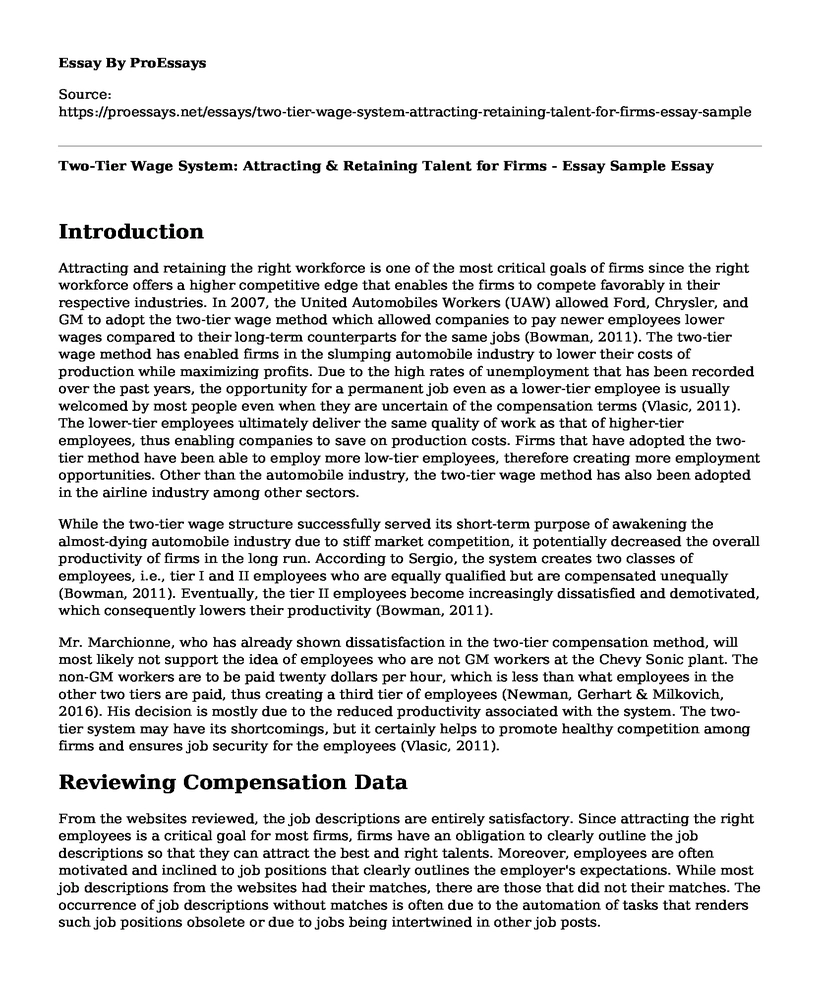Introduction
Attracting and retaining the right workforce is one of the most critical goals of firms since the right workforce offers a higher competitive edge that enables the firms to compete favorably in their respective industries. In 2007, the United Automobiles Workers (UAW) allowed Ford, Chrysler, and GM to adopt the two-tier wage method which allowed companies to pay newer employees lower wages compared to their long-term counterparts for the same jobs (Bowman, 2011). The two-tier wage method has enabled firms in the slumping automobile industry to lower their costs of production while maximizing profits. Due to the high rates of unemployment that has been recorded over the past years, the opportunity for a permanent job even as a lower-tier employee is usually welcomed by most people even when they are uncertain of the compensation terms (Vlasic, 2011). The lower-tier employees ultimately deliver the same quality of work as that of higher-tier employees, thus enabling companies to save on production costs. Firms that have adopted the two-tier method have been able to employ more low-tier employees, therefore creating more employment opportunities. Other than the automobile industry, the two-tier wage method has also been adopted in the airline industry among other sectors.
While the two-tier wage structure successfully served its short-term purpose of awakening the almost-dying automobile industry due to stiff market competition, it potentially decreased the overall productivity of firms in the long run. According to Sergio, the system creates two classes of employees, i.e., tier I and II employees who are equally qualified but are compensated unequally (Bowman, 2011). Eventually, the tier II employees become increasingly dissatisfied and demotivated, which consequently lowers their productivity (Bowman, 2011).
Mr. Marchionne, who has already shown dissatisfaction in the two-tier compensation method, will most likely not support the idea of employees who are not GM workers at the Chevy Sonic plant. The non-GM workers are to be paid twenty dollars per hour, which is less than what employees in the other two tiers are paid, thus creating a third tier of employees (Newman, Gerhart & Milkovich, 2016). His decision is mostly due to the reduced productivity associated with the system. The two-tier system may have its shortcomings, but it certainly helps to promote healthy competition among firms and ensures job security for the employees (Vlasic, 2011).
Reviewing Compensation Data
From the websites reviewed, the job descriptions are entirely satisfactory. Since attracting the right employees is a critical goal for most firms, firms have an obligation to clearly outline the job descriptions so that they can attract the best and right talents. Moreover, employees are often motivated and inclined to job positions that clearly outlines the employer's expectations. While most job descriptions from the websites had their matches, there are those that did not their matches. The occurrence of job descriptions without matches is often due to the automation of tasks that renders such job positions obsolete or due to jobs being intertwined in other job posts.
The salary development information is not adequate since the only data provided is just a range and is therefore not accurate and specific. Factors such as inadequate job descriptions and competitor participation lead to inaccuracy of data. Implications of inaccurate data include dissatisfaction of employees, which in return, lowers the overall productivity of employees.
Compensations for similar jobs vary from one location to the other and is often a subject of competition, availability of labor, and working conditions, among other factors. Form the survey interns are the lowest paid while the managers are the highest paid, and the discrepancies are enormous (Newman et.al., 2016). The difference in wages is due to experience and their varied job descriptions. A consultant's survey is essential for a company as it enables it to be on par with its competitors and promotes healthy competition. As a manager, I would justify paying higher or lower than what is provided in the website since compensation is dependent on the value that the employee is adding to the company.
References
Bowman, Z. (2011, October 28th). Marchionne:Two-tier wage structure untenable. AutoBlog. https://www.autoblog.com/2011/10/28/marchionne-two-tier-wage-structure-untenable/
Newman, J. M., Gerhart, B., & Milkovich, G. T. (2016). Compensation. McGraw-Hill Higher Education. http://mcbwr.esy.es/compensation-milkovich-11th-edition.pdf
Vlasic,B. (2011, September 13th). Detroit Sets Its Future on a Foundation of Two-Tier Wages. The New York Times. https://www.nytimes.com/2011/09/13/business/in-detroit-two-wage-levels-are-the-new-way-of-work.html?_r=1&pagewanted=all
Cite this page
Two-Tier Wage System: Attracting & Retaining Talent for Firms - Essay Sample. (2023, Apr 05). Retrieved from https://proessays.net/essays/two-tier-wage-system-attracting-retaining-talent-for-firms-essay-sample
If you are the original author of this essay and no longer wish to have it published on the ProEssays website, please click below to request its removal:
- Taxation Theory, Practice and Laws
- Essay Sample on Morality of Capitalism
- A Study on the Relationship Between Wage Rate and Quit Rate
- Technical and Vocational Education and Training Programs and the Labor Market Demand in Liberia
- Essay Example on Business Leaders: Making Smart Decisions for Societal Benefits
- The US Debt Crisis: A History of Borrowing and Lending - Essay Sample
- Paper Example on Dr. Oz: Welcoming Audience & Delivering Main Points







